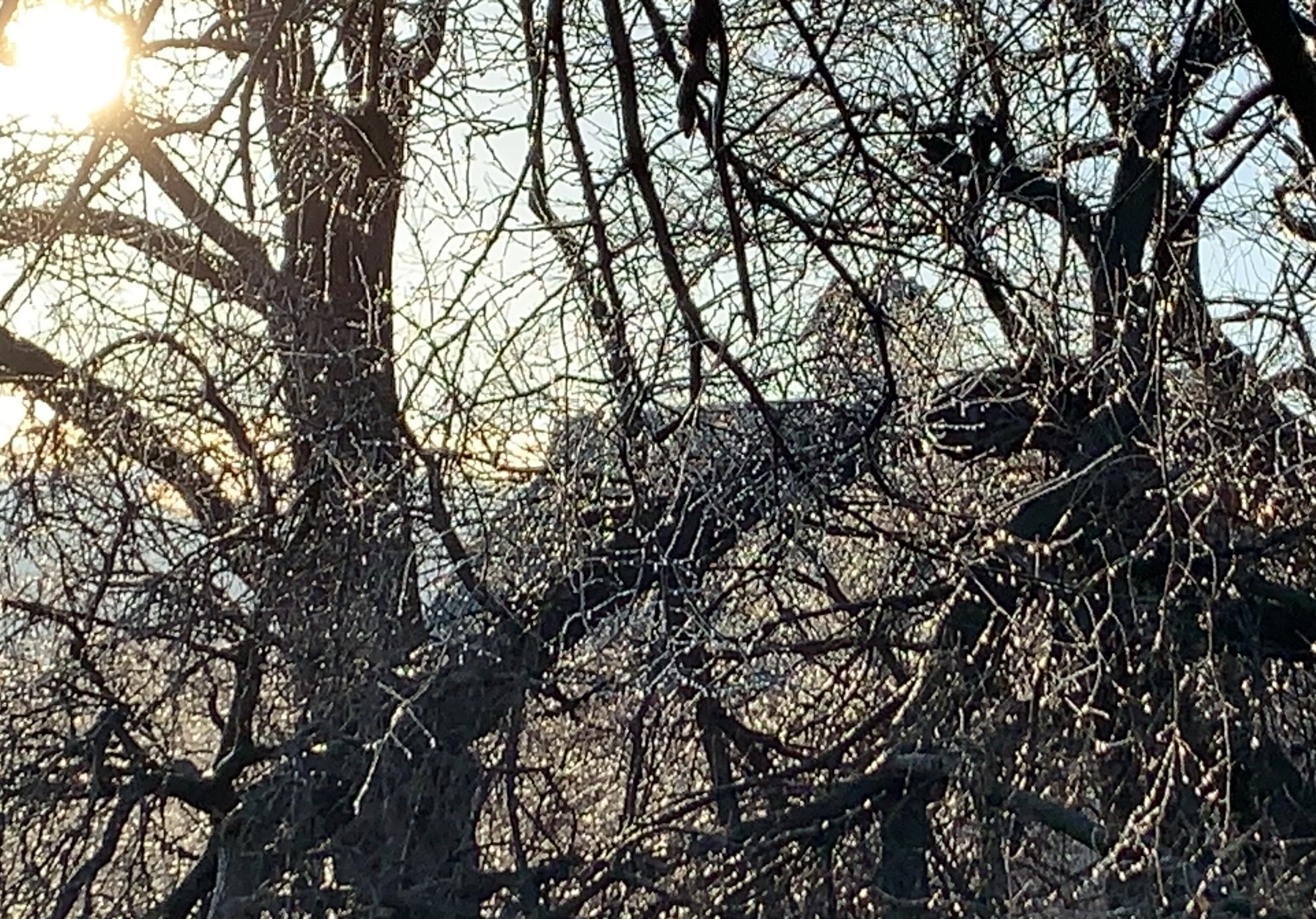The world is covered in ice. Ice on the porch; ice on the railing; ice on the sidewalk; ice on the power lines. Ice-covered branches tick against each other, filling the soundscape with confetti. The wind chimes, usually authoritative in their announcement of wind from the southeast, are coated with ice. Instead of their bright, pentatonic ringing, they clunk as though they were made of wood or bamboo instead of brass. Peeping comes from the dark-eyed juncos on the ground underneath the bird feeder, and a woodpecker makes a statement off in the icy trees. The wind is light, moving the branches slowly so they almost look like they’re breathing. A train whistle lances through the stillness. It’s followed by the rhythmic song of commerce passing in a long line of tank cars, grain cars, boxcars, and shipping containers. The rumble of the train temporarily overwrites the soundscape until it recedes, giving back the gentle rattle of the ice-laden branches. If the sun comes out, the ice will sparkle and begin to melt, but so far it’s cloudy and cold. Little pellets of sleet crunch underfoot on the sidewalk, testimony to last night’s sleet and freezing rain.
Several specific conditions can create sleet and freezing rain. The basics, though, are all about layers—in this case layers of air above Owl Acres. High above the ground, clouds rally, filled with growing raindrops or ice crystals, depending on how cold it is up there. It may actually be warmer than the ground at this point. If it’s below freezing, the raindrops will freeze into ice drops. Either way, these raindrops get too heavy to stay in the clouds and begin descending. As they come down, they pass through layers of air at different temperatures. Closer to the ground, they pass through a relatively warm layer of air where they melt. Then they hit a cold layer of air trapped beneath the warm layer. The thickness of this cold layer of air determines whether we get sleet or freezing rain.
If the layer is thick enough, and it takes the raindrops long enough to drop through it, they will freeze into discrete pellets of ice. If the cold layer is thinner, and the raindrops spend less time dropping through it, they will not freeze into ice pellets. Instead they will become super-cooled. That is, the temperature of the raindrops is several degrees below freezing, but they don’t have time to freeze solid. However, when these super-cooled raindrops land on something cold and solid like a tree branch or a power line, they freeze almost immediately.
Our ice storm started out as sleet, spattering against the windows in a haze of sound. The sleet was formed when raindrops or snow crystals in the upper atmosphere dropped through a relatively warm layer of air and melted. Then they hit a much colder blanket of air which froze the individual liquid raindrops into little pellets of ice. These pellets of ice landed on the sidewalk and driveway pad and began to pile up. Soon, however, conditions changed. The layer of air near the ground that froze the sleet pellets thinned. It was no longer thick enough to freeze the droplets as they passed through it. What it did do, however, was supercool the droplets. They remained in liquid form, but at a temperature several degrees below freezing. If they landed on something warm, like say Dave and Clancy out for their evening romp, they didn’t freeze. But when the supercooled droplets of rain landed on surfaces that were below freezing, they froze almost instantly. Some of them slid around to the underside of the branches before they froze solid, creating an uneven distribution of ice on the branch. Wind also blew the raindrops in one direction, causing the ice to build up faster on the windward side than on the leeward side of everything from the tree branches to our owl sculpture. By morning, everything was coated in ice. With temperatures hovering just above freezing, the ice began to melt, dripping off the roof and dropping onto the frozen grass. Later in the day, when nightfall lowered temps, the melted ice would freeze again in new configurations including adding a sheet of ice to the sidewalk.
Ice storms are rare on Owl Acres. They occur generally about once a year. As the winters warm, however, we may be in for more of them. When it’s cold enough, it snows. But when the temperatures hover around freezing as they have been recently, ice storms like the one we just had are more likely to occur. Along with the sparkly trees and intriguing soundscapes, it means hazardous walking and driving conditions, power outages, and tree limbs down. I’ll postpone my walk with Dave and Clancy until the ice is gone from the road.
Photo by Author. Alt text: The morning after an ice storm on Owl Acres. The trees are coated in glass, turned crystal by the rising sun. A ghost image of the barn is visible through the tangle of defoliated trees in the foreground.

2 comments
Thank you for these missives Karen. My granddaughter in middle school thinks they are wonderful, so does her mom, and so does her grandpa. What a range of reader you reach.
Thank you. I am enjoying writing Heartland Safari, and I’m so happy to share what I’m discovering. There’s so much life all around us! It’s exciting to recognize and learn about it.